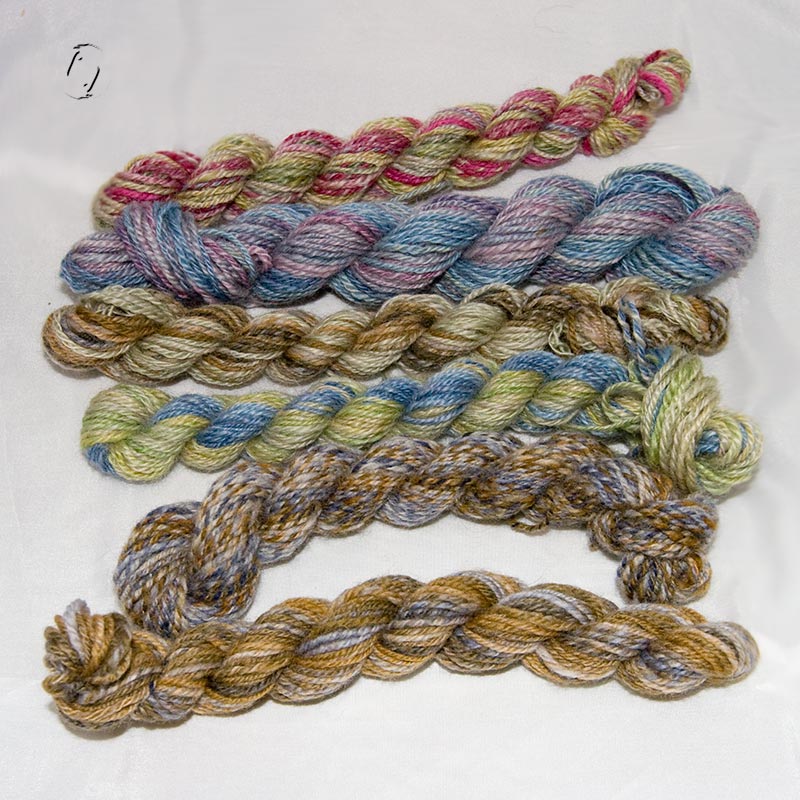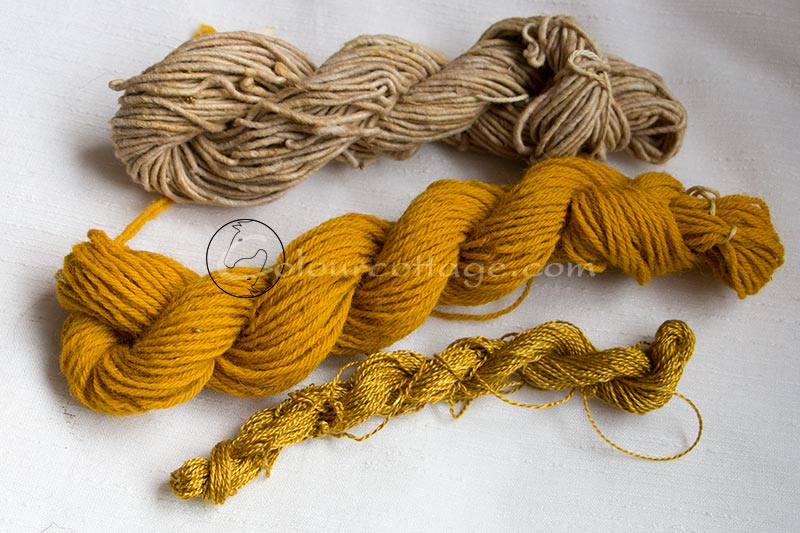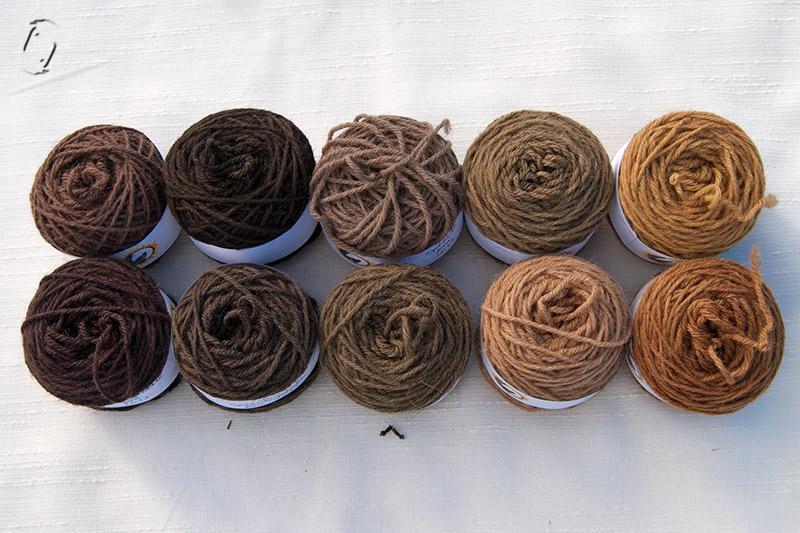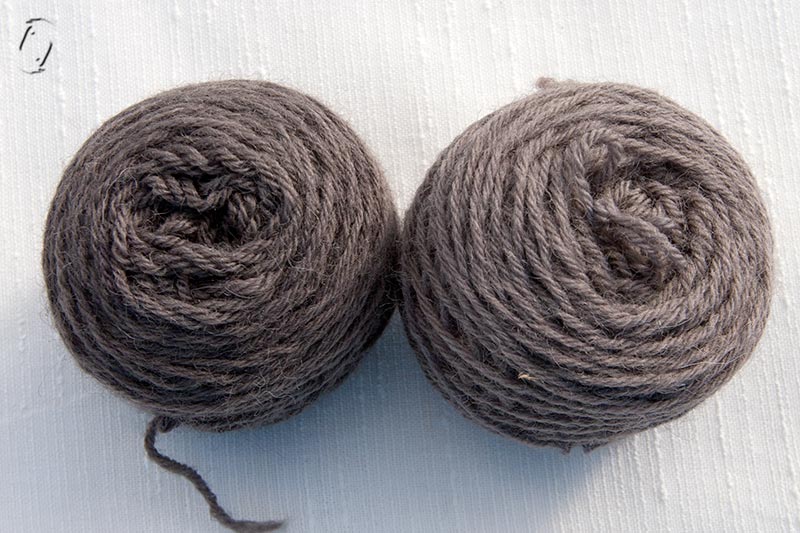…and nothing to do with it. That’s what I’ve been thinking every time I pass by my second year weld, lush, tall and proud. Because as I mentioned in the fennel post A. I don’t have a new dye yarn supply, B. I don’t really want to keep dyeing samples with cheap yarn, C. I don’t have any projects planned that require a large quantity of yellow yarn, and D. I just haven’t felt like it anyway. Which is a shame, because it is one of the plants I want to keep using in the more limited range that I’ve set out to use in the future (rather than try all the things).
Tag: silk
Fennel dye
Natural dyeing with fennel | gather and grow.
Last year I was inspired to sow bronze fennel, even though I thought I was through with food dyeing. Rita Buchanan also mentions it in her book. This year my plants are really growing, so I decided to give it a go. One wool skein, two silk, all alum mordanted.
Selling scraps
Birdie mentioned whether I’d sell the plant dyed yarns I’m not using (especially if they were fabrics). Raquel always wants to make scarves from it. 😉 My reply was, that until now I’ve used cheap, scruffy wool in very small skeins, so not very interesting for knitting at least, and I’m not really sure anyone would want it if they saw felt it in person.
Since I’m changing directions slightly both with my dyeing and yarn crafting, I thought it would be fun to do a survey, not because I expect any who reply to buy anything, but to help me choose materials. For myself mainly, but yes, if I could hand over an unwanted skein now and again in return for the ability to buy a couple of new ones to modify, that would be awesome. Sometimes I have an idea but abandon it halfway not because I hate the result, I just moved on quicker than my production pace.
I’d like to do more silks – mostly yarn, since fabric is expensive, so probably small quantities for needlework. Which yarn weights and skein lengths do you stitchery folks prefer? Do you use wool, and then which type? Chances are, you can teach me which threads I’d like to use myself…
I’m also probably going to experiment with dyeing wool fabric. Either handwoven or what I find. There will be fabric ends leftover from my weaving of all sorts. Do people look for small amounts of handwoven for quilting or textile “paintings” like some use handspun and handdyed mini-skeins? Would be über cool to swap or see a bit of my stuff used in someone elses stuff!
In which case, what types of fabric do you look for, when you look?
Cellulose fibers such as cotton and linen are out of my league now. They are difficult to dye. I do not have the energy to go into it this year, or ever. It doesn’t feel important when I know I can make protein fibers shine.
I have considered dyeing larger quantities of some nice knitting yarn, because I had various requests. Problem is, people talk but they don’t pay up front and I can’t afford to stock up on many kilos of nice yarn. If I have to spin it myself I’m not going to part with it for “a friendly price”! And I’m not really looking to set up an actual shop for small items that demand too much time compared to their price. At least not at my current energy level.
So anyway, while I’m trying out this tapestry/artistic weaving thing with ideas of some embroidery on top or meshed in specialty yarns, searching for a path among different types of yarns than I’m used to, I basically would like to hear what everybody else out there likes for various purposes. I hope to narrow down my spinning and weaving baseline staple to a few things that I use 80-90% of the time rather than have 300 g of every fiber under the sun.
I also don’t know yet what I’m going to “major” in. Will it be weaving or making/designing yarn? Or is textiles simply my grounding exercise that keeps the more brainy creativities alive, such as photo(shopping), writing – and what about the painting? I feel like I’m trying various things out, like different semesters in an education, and eventually perhaps I’ll fall deeper into one than the others. Which means leftovers from the activities that end up on the back shelf.
Winter goldenrod
There have been comments about my use of freezer space 😉 so I thought I’d get at least one experiment done “for the books” after I’d seen these puffs in the December sun.
I’d saved a guesstimate of 500 g of heads, no leaves. Enter 25 g of wool, 3 silk, 30 cotton previously dye fail with iron and weld, thought it would be interesting with the high dye ratio (it wasn’t). Careful not to boil and leave it as long as last time. Steeped overnight:
Things to ponder:
What would the same dye ratio look like with fresh plants? I could have put more into this pot to exhaust the bath, as I’m sure there’s plenty left, but I didn’t have the heart to. I have so many yellow skeins and I just don’t use that colour very much.
Is it my temperature or the species of Goldenrod that gives me the bronze colours rather than bright yellow? (as seen elsewhere)
Oak leaves
Green leaves picked September 11th. Dried some, frozen some, to dye on silk, cotton and a sample strip wool only. The rest dyed immediately. Test also early summer leaves 2014 as well as brown self-dried.
4:1 fresh, 2:1 dry – oak galls 2% if colour not strong.
Those are my notes in short form. 😉 What that means is, I’ve dyed some wool 4:1 ratio, with and without premordant, and same with an iron afterbath. Then I did it again with oak galls in there too. You don’t quite see it in the photo below, but the dark skeins are actually a deep, chocolate brown, and the ones with iron minus oak galls are greenish.
The oak galls don’t appear to do much to the oak colour itself, it works with the iron. Don’t leave your yarn in there too long unless you are aiming for black!!! Half an hour the old books say. First dye for an hour, add iron, simmer another half.
Technically people use oak to get grey, a wonderful smoky/silver shade. I got all sorts of brown and grey shades, but not that one!
So I’ve saved a few leaves in the freezer as well as dried some to test later. Perhaps the grey is more easily obtained on cotton?
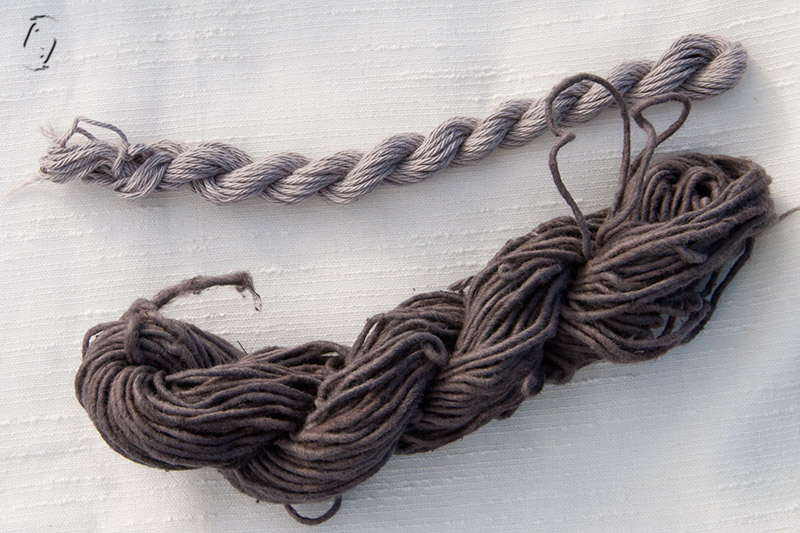
Then I had a stroke of genious if I may say so. Especially since I had not bothered to actually check what other people do, I just followed the book. What if I did NOT dye the yarn first, but plunked it into the iron/oakgall/leaf bath when it was squeaky clean?!
But I’m kinda glad I did follow instructions first, or I would never have gotten all those other shades. Of course now I’m wondering what happens if you just use iron and oak galls…..
Oh – and if you rinse and rinse and the water still comes out black as night – make sure you don’t have a piece of oak gall trapped in your fiber. 😉
Egeblade
De gamle bøger siger: egeblade vægt 4:1 friske, 2:1 tørrede. 2% galæble for at få mørkere farve.
Så det prøvede jeg. Man skal passe på ikke at lade det ligge i gryden for længe efter tilsat jern, med mindre man går efter sort, en halv time er vist passende.
Galæblerne gjorde ikke rigtig noget ved selve farven, de virker først sammen med jern, her var der en tydelig forskel på de “grå” nuancer jeg fik. Måske de flotte sølvgrå jeg har set, har været på bomuld? Indtil det faldt mig ind at IKKE gøre som i bogen, nemlig farve i blade først, og så putte jern i til sidst. Og det virkede. Men jeg er da ret glad for, at jeg ikke checkede hvordan andre gør, for så havde jeg jo aldrig fået alle de fine brune!
Jeg farvede både ubejdset (det er det, de fleste bruger) samt alun- og kobberbejdset, her var også klar forskel, så man kan let skabe sig en gradueret skala til brug ved flerfarvearbejde.





